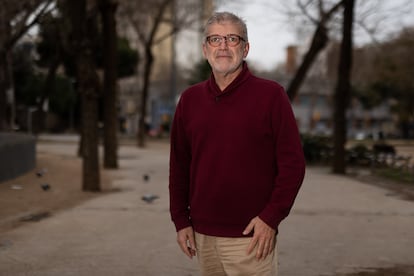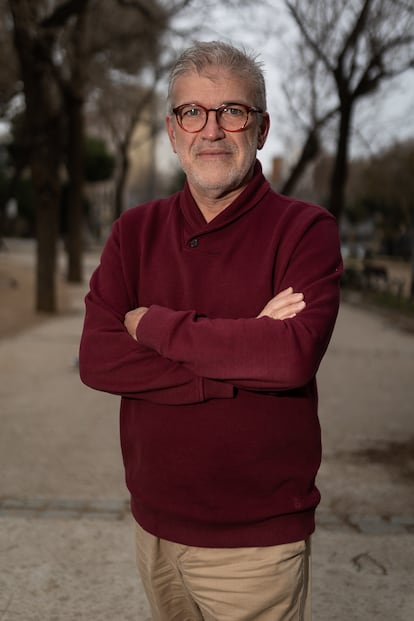‘Science has proven for decades that tobacco kills and the goal must be to eradicate it’
Spanish expert Esteve Fernández applauds New Zealand’s initiative to phase out access to tobacco entirely but warns that the industry is using e-cigarettes to create new generations of smokers

Every year, around the world, over eight million people die due to tobacco use, according to the World Health Organization. Of these, more than seven million die from direct use and around 1.2 million from the effects of second-hand smoke. In Spain, around 50,000 people die annually due to smoking, according to estimates published by the Ministry of Health. Esteve Fernández, head of the Tobacco Control Unit of the Catalan Institute of Oncology, describes this is a “terrible epidemic.” Fernández, who is also a professor of public health at the University of Barcelona, welcomed the “very good news” of the New Zealand government’s commitment to ensure that the country’s new generations will grow up free of nicotine in what is the boldest initiative in the world to date to put an end to the damage caused by this legal drug. Wellington’s legislation will prevent anyone born after 2009 from buying tobacco, even when they turn 18, with an year-on-year increase on the legal age to buy cigarettes: In theory, somebody trying to buy a pack of cigarettes in New Zealand 50 years from now would need ID to show they were at least 63 years old.
Question. Why do you think the New Zealand government’s plans are a good idea?
Answer. Science has proven for decades that tobacco kills and the goal must be to eradicate it to avoid its harmful consequences. It is a product that leads to addiction and causes irreparable damage to health. [New Zealand] is the first country to move toward new generations free of smokers in a way that is backed by scientific results. It is a proposal that will lead us to societies free of this drug.
Q. How can you be sure of that if a law like this has never been applied?
A. We know that limiting access to tobacco reduces consumption. The evidence is very clear on this and we have already applied it by banning the purchase of tobacco by minors. Making it impossible for entire generations to buy tobacco for the rest of their lives is a step closer to the end of this terrible epidemic. Of course, this must be accompanied by other measures. New Zealand plans to reduce points of sale by 95%. Unfortunately, in Spain we have taken some steps in the opposite direction (a recent revision of Spain’s tobacco legislation permitted the sale of cigarettes from machines in 24-hour convenience stores).
Q. How will the New Zealand law work, for example, in a household with adult children where the parents smoke?
A. The law will not prohibit smoking, it will prohibit the purchase of tobacco. If the young person decides to smoke and gets hold of cigarettes one way or another, that will be something that will have to be worked on with other preventive measures: awareness campaigns, interventions in schools, with families, by raising the price of tobacco...
Q. Why do young people start smoking?
A. The initiation of tobacco use has an individual component as well as a group or contextual component. The tobacco industry has invested a lot of money to transmit to young people that smoking will make them feel different, daring, older... In many movies, the tough guys, the rebels, are smokers. For women, smoking was promoted as a way to achieve equality. Marketing strategies segmented the market into population groups, and they delivered messages to each of them designed to promote consumption. This strategy is still applied today with influencers on social networks.
Q. And in the group context?
A. Young people usually experiment because of peer pressure. If there is a smoker in the gang, he will try to get the rest to join him. If a young person joins a group where there are already two or three smokers, it can become a way to integrate. It is also a way, mistakenly, of showing that one is getting older. There are a number of variables that influence the decision to try a cigarette.

Q. These variables are the ones that New Zealand wants to cut down on...
A. Yes. In adolescence, these issues are key and cutting off access to cigarettes is the best way to avoid everything that comes afterward. We know that adolescents who have access to tobacco because there are smokers in the family or in their immediate environment are more likely to start smoking. We have seen this in different contexts and different cultures.
Q. At what age do young people generally start to smoke?
A. It is very rare for someone to start smoking after the age of 20. Evidence shows that experimentation begins between the ages of 13 and 15. If the situation is not curbed then and continues until the age of 18, many will continue to smoke for decades.
Q. Are there any other countries considering this kind of measure?
A. Yes, it is an approach that is gaining traction among those responsible for public health. At the moment these initiatives are being put together, put on the table, and they are beginning to be considered by those governments that are most sensitive to the issue. In our immediate environment, the debate is already open in Denmark and Scotland. In the United States, these regulations are very fragmented, but the town of Brookline, near Boston, for example, is already taking the first steps. And there are similar cases in parts of the Philippines, Malaysia...
Q. Is raising the price of tobacco a viable option?
A. Yes, we have proven scientifically that tobacco is a product that has what economists call elasticity; when the price goes up, many people react to the change. Some reduce their consumption, others switch to a cheaper brand and, finally, there is a considerable group that considers making a serious attempt to quit smoking. And some succeed with the treatments and resources available. Some people say that we are completely stagnant, but that is not the case.
Q. Who is of that opinion?
A. There are groups that use this argument to promote other forms of nicotine consumption. This is what has become known as the harm reduction strategy, which is nothing more than trying to replace tobacco consumption with other forms that we could say are a little cleaner, but equally addictive and that still contain substances that are harmful to health. I am referring to electronic cigarettes and vapes.
Q. But if these are less harmful, isn’t that a good option?
A. They are still harmful. Nicotine is not in itself a carcinogen, but it is a promoter that, let’s say, paves the way for other toxins and carcinogens to work better. It is also an inflammatory and we know that there are cardiovascular diseases that originate by inflammation in organs of the circulatory system and these are assisted by nicotine, whatever its origin. Nor has it been proven that switching from conventional cigarettes to these products really reduces the risks, because many people combine tobacco with these devices and continue to be exposed to carcinogenic substances. There is a scientific consensus that palliation of harm is neither a desirable nor an effective strategy in the face of an addiction that affects millions of people.
Q. Do these devices provide a gateway for new smokers?
A. That is the other big problem. As the industry is aware of it, it is investing a lot of money in it. Today young people go out to party and, as they are readily available, they try vapes. Some have nicotine, some are nicotine-free, there are fruit flavored ones... They are being introduced in leisure environments with a supposedly banal image, because young people are told that they are not as bad as tobacco. We are opening the door for them to have greater access and we know where that leads. A significant number of them will end up addicted to nicotine. The industry knows this and because they make vast sums of money, they can invest large amounts in recruiting new people to smoking.
Q. How are public health policies approached when they interfere with personal decisions such as smoking?
A. Public interest is the one that must prevail. Obviously, everyone has the right to do what he or she wants, as long as it does not interfere with the public interest. You can’t force anyone to quit smoking, but all the conditions have to be in place so that people can make the decision freely. And an addiction is not a situation of freedom as we understand it. The public and individual interest is to prevent a person from becoming addicted, to give him/her all the information about the damage this causes and the tools to stop being addicted if he/she so wishes. The supposed dilemma between “individual liberties and collective good” is a false dilemma. However, there is an interest within the industry and certain ideologies to stir it up, and that in the end goes against collective health.
Sign up for our weekly newsletter to get more English-language news coverage from EL PAÍS USA Edition
Tu suscripción se está usando en otro dispositivo
¿Quieres añadir otro usuario a tu suscripción?
Si continúas leyendo en este dispositivo, no se podrá leer en el otro.
FlechaTu suscripción se está usando en otro dispositivo y solo puedes acceder a EL PAÍS desde un dispositivo a la vez.
Si quieres compartir tu cuenta, cambia tu suscripción a la modalidad Premium, así podrás añadir otro usuario. Cada uno accederá con su propia cuenta de email, lo que os permitirá personalizar vuestra experiencia en EL PAÍS.
¿Tienes una suscripción de empresa? Accede aquí para contratar más cuentas.
En el caso de no saber quién está usando tu cuenta, te recomendamos cambiar tu contraseña aquí.
Si decides continuar compartiendo tu cuenta, este mensaje se mostrará en tu dispositivo y en el de la otra persona que está usando tu cuenta de forma indefinida, afectando a tu experiencia de lectura. Puedes consultar aquí los términos y condiciones de la suscripción digital.
More information
Archived In
Últimas noticias
Most viewed
- Sinaloa Cartel war is taking its toll on Los Chapitos
- Oona Chaplin: ‘I told James Cameron that I was living in a treehouse and starting a permaculture project with a friend’
- Reinhard Genzel, Nobel laureate in physics: ‘One-minute videos will never give you the truth’
- Why the price of coffee has skyrocketed: from Brazilian plantations to specialty coffee houses
- Silver prices are going crazy: This is what’s fueling the rally










































